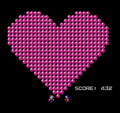Family BASIC: Difference between revisions
(transplant unencyclopedic text from https://en.wikipedia.org/w/index.php?title=Family_BASIC&diff=865914799&oldid=860238246) |
|||
| Line 1: | Line 1: | ||
{{construction}} | |||
{{more images|maybe?}} | {{more images|maybe?}} | ||
{{about|the accessory for the Family Computer|the microgame in ''[[WarioWare, Inc.: Mega Microgame$!]]''|[[Family Basic]]}} | {{about|the accessory for the Family Computer|the microgame in ''[[WarioWare, Inc.: Mega Microgame$!]]''|[[Family Basic]]}} | ||
| Line 7: | Line 8: | ||
|Dis=Unknown{{ref needed}} | |Dis=Unknown{{ref needed}} | ||
}} | }} | ||
'''Family BASIC''' is an accessory for the [[Family Computer]] (Famicom) created by [[Hudson Soft]] and [[Wikipedia:Sharp Corporation|Sharp Corporation]]. It allowed users to create programs in the [[Wikipedia:BASIC|BASIC programming language]]. This accessory came with a special designed cartridge, keyboard, and the ''Data Recorder'', similar in function to that of a [[Wikipedia:Commodore International|Commodore computer]] of that era. | |||
The keyboard plugs into a 15-pin expansion port on the front of the Famicom and the ''Data Recorder'' plugs into the back of the keyboard labeled '''SAVE''' and '''LOAD'''. If one does not have the ''Data Recorder'' or spare cassette tape (or finds cassette tape technology too inconvenient), one can just use the microphone and headphone jacks of a computer or similar device to record the analog signal coming from the keyboard with their preferred audio recording program and then play it back when the game is requesting data to be loaded.<ref>https://www.youtube.com/watch?v=__9VYaKMwQI&t=12m45s</ref> | The keyboard plugs into a 15-pin expansion port on the front of the Famicom and the ''Data Recorder'' plugs into the back of the keyboard labeled '''SAVE''' and '''LOAD'''. If one does not have the ''Data Recorder'' or spare cassette tape (or finds cassette tape technology too inconvenient), one can just use the microphone and headphone jacks of a computer or similar device to record the analog signal coming from the keyboard with their preferred audio recording program and then play it back when the game is requesting data to be loaded. <ref>https://www.youtube.com/watch?v=__9VYaKMwQI&t=12m45s</ref> | ||
Three games are compatible with the Data Recorder: | Three games are compatible with the ''Data Recorder'': | ||
* ''[[Wikipedia:Excitebike|Excitebike]]'' | * ''[[Wikipedia:Excitebike|Excitebike]]'' | ||
* ''[[Wikipedia:Mach Rider|Mach Rider]]'' | * ''[[Wikipedia:Mach Rider|Mach Rider]]'' | ||
* ''[[Wrecking Crew]]'' | * ''[[Wrecking Crew]]'' | ||
This accessory features the cameo appearances of [[Mario]] and [[Pauline]] when the | This accessory features the cameo appearances of [[Mario]] and [[Pauline]] when the '''Family BASIC''' cartridge is being played. | ||
==Gallery== | ==Gallery== | ||
Revision as of 21:08, November 3, 2018
This article is under construction. Therefore, please excuse its informal appearance while it is being worked on. We hope to have it completed as soon as possible.
- This article is about the accessory for the Family Computer. For the microgame in WarioWare, Inc.: Mega Microgame$!, see Family Basic.
Template:System-Infobox Family BASIC is an accessory for the Family Computer (Famicom) created by Hudson Soft and Sharp Corporation. It allowed users to create programs in the BASIC programming language. This accessory came with a special designed cartridge, keyboard, and the Data Recorder, similar in function to that of a Commodore computer of that era.
The keyboard plugs into a 15-pin expansion port on the front of the Famicom and the Data Recorder plugs into the back of the keyboard labeled SAVE and LOAD. If one does not have the Data Recorder or spare cassette tape (or finds cassette tape technology too inconvenient), one can just use the microphone and headphone jacks of a computer or similar device to record the analog signal coming from the keyboard with their preferred audio recording program and then play it back when the game is requesting data to be loaded. [1]
Three games are compatible with the Data Recorder:
This accessory features the cameo appearances of Mario and Pauline when the Family BASIC cartridge is being played.
